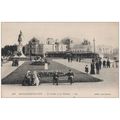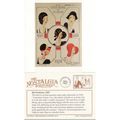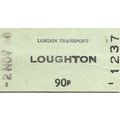Tokyo, Japan - Monorail, Trading Centre Building - postcard 1975 pmk
- Condition : Used
- Dispatch : 2 Days
- Brand : None
- ID# : 215792767
- Quantity : 1 item
- Views : 244
- Location : United Kingdom

- Seller : justthebook (+1704)
- Barcode : None
- Start : Thu 16 Feb 2023 13:40:27 (EDT)
- Close : Run Until Sold
- Remain : Run Until Sold
Checks/Cheques
 for 1 item(s) edit
for 1 item(s) edit
Shipping Calculator
More Listings from This Seller view all
Seller's Description
- Postcard
- Picture / Image: "Mono-Rail and the Trading Center Building"
- Publisher: in Japanese
- Postally used: yes
- Stamp: Japan 55
- Postmark(s): Tokyo 1975
- Sent to: Sunbury-on-Thames, Surrey, England
- Notes / condition:
Please ask if you need any other information and I will do the best I can to answer.
Image may be low res for illustrative purposes - if you need a higher definition image then please contact me and I may be able to send one. No cards have been trimmed (unless stated).
------------------------------------------------
Postage & Packing:
Postage and packing charge should be showing for your location (contact if not sure).
No additional charges for more than one postcard. You can buy as many postcards from me as you like and you will just pay the fee above once. Please wait for combined invoice. (If buying postcards with other things such as books, please contact or wait for invoice before paying).
Payment Methods:
UK - PayPal, Cheque (from UK bank) or postal order
Outside UK: PayPal ONLY (unless otherwise stated) please. NO non-UK currency checks or money orders (sorry).
NOTE: All postcards are sent in brand new stiffened envelopes which I have bought for the task. These are specially made to protect postcards and you may be able to re-use them. In addition there are other costs to sending so the above charge is not just for the stamp!
I will give a full refund if you are not fully satisfied with the postcard.
----------------------------------------------
Text from the free encyclopedia WIKIPEDIA may appear below to give a little background information (internal links may not work) :
*************
The Tokyo Monorail (東京モノレール, Tōkyō Monorēru), officially the Tokyo Monorail Haneda Airport Line (東京モノレール羽田空港線, Tōkyō Monorēru Haneda Kūkō sen), is a monorail line in Tokyo, Japan. An airport rail link, it connects Tokyo International Airport (Haneda) to Tokyo's Ōta, Shinagawa, and Minato wards. The 17.8-kilometer (11.1 mi) line serves eleven stations between the Monorail Hamamatsuchō and Haneda Airport Terminal 2 stations. It operates on a predominantly elevated north–south route that follows the western coast of Tokyo Bay. The Tokyo Monorail is one of two rail lines serving the airport, with the other being the Keikyū Airport Line. At Hamamatsuchō Station, its passengers may transfer to the Keihin–Tōhoku and Yamanote lines of JR East, as well as the Asakusa and Oedo lines of the Toei Subway via nearby Daimon Station. The monorail also connects with Tokyo Waterfront Area Rapid Transit's Rinkai Line at Tennōzu Isle Station.
Plans for Japan's first airport rail link were announced in 1959 as Tokyo prepared to host the 1964 Summer Olympics.
Devastated from the Second World War, Japan's commercial aviation industry recovered in the early 1950s. By this time, Tokyo's Haneda Airport emerged as the country's largest transport hub and international gateway. In 1959, the airport recorded approximately 910,000 total passengers and expected many more for the coming 1964 Summer Olympics. As a result, the government unveiled a plan for a central Tokyo-to-airport rail link. Opponents of the rail line briefly countered with a proposal to extend the Tokyo Expressway instead, but fears that this would only worsen vehicular congestion led to a preference for rail.[3]:9
Established in 1960, the Japan Elevated Railway Co., Ltd., later the Tokyo Monorail Co., Ltd., selected an Alweg-type monorail for the line's preferred mode alternative. This was due to two factors. First, the company's president, Tetsuzo Inumaru, was an old friend of Dr. Axel Wenner-Gren, the founder of Alweg. Second, Hitachi, Ltd., which would build the line, was keen on further developing the technology.[3]:9
Project planners originally intended the monorail line to extend from Haneda Airport to Shimbashi or Tokyo Station,[4] and a license had been acquired to build it up to either station.[5]:3 However, opposition from residents living near the Shibaura Canal, which had been part of the proposed route,[6] as well as cost overruns during the construction of the Tōkaidō Shinkansen, which drained government subsidies, resulted in a shortened route to Hamamatsuchō Station. To further minimize costs, the line was routed over other public waterways donated by local municipalities, which eliminated the need to acquire expensive private land, but reclaimed parts of Tokyo Bay, as well as rivers and canals. The resulting alignment removed a number of fishing and aquatic farming operations, and local fishing cooperatives had their licences revoked by the Tokyo Metropolitan Government. Among them was a seaweed harvesting field in Ōta Ward that had produced a premium brand of nori since the Edo period called Omori no nori.[4]
The Ministry of Transport authorized the monorail project in December 1961.[3]:9 Construction of the line progressed rapidly. Work began on May 1, 1963,[7]:248 and service commenced on September 17, 1964, 23 days ahead of the Olympic opening ceremony on October 10.[8] The line cost a total of 21.1 billion yen (equivalent to approximately $60 million in 1964 dollars[9]), of which 20 billion yen was spent for construction and 1.1 billion yen on rolling stock.[3]:9 Hitachi built the first-generation cars in Japan, which were inspired by the original Alweg design developed for the Seattle Center Monorail and the original Disneyland Monorail. Upon its inauguration, the Tokyo Monorail became the world's first commercial monorail service and Japan's first airport rail connection.[10][11]
At the time of opening, the Tokyo Monorail ran a total length of 13.1 kilometers (8.1 mi) and served only its termini: Hamamatsuchō Station and the airport. Most of the artificial islands in Tokyo Bay had not yet been reclaimed, and the line mostly ran over water.[12] The price for a one-way ticket was 250 yen,[13][14] which was relatively more expensive than other available options at the time. It was notably cheaper to take a taxi with four people to the airport than to ride the monorail. A recession following the Olympics resulted in a decrease in airport arrivals, which severely affected ridership. In 1966, the Tokyo Monorail was forced to reduce the price of its fare to 150 yen to attract more passengers.[12]
Infill stations and later expansions
Ōi Keibajō Mae became the monorail's first infill station upon its completion in May 1965. It was originally built as a temporary station along the coast above the water and it only operated on days when an event was taking place at Ohi Racecourse. Its permanent replacement opened in June 1967. The city government subsequently reclaimed the area around this station and developed a housing complex today known as Yashio Park Town [ja].[12] Between 1967 and 1993, four more stations were built along the original alignment. These were Haneda Seibijō, later renamed Seibijō (1967); Shin Heiwajima, later renamed Ryūtsū Center (1969); Shōwajima (1985); and Tennōzu Isle (1992).[5]:3
When the monorail began operation, the passenger terminal at Haneda Airport was located on the west side of the airfield, south of Seibijō, and this was the southern end of the monorail. Upon the opening of a new passenger terminal—now Terminal 1—in 1993, the monorail was extended to a new platform and another station, Shin Seibijō, was built for the employees of nearby maintenance facilities.[5]:4 Meanwhile, the former passenger terminal was razed and the monorail tunnel beneath it was abandoned to make room for an extension of Runway B.[15] The original Haneda Station, which was abandoned along with the tunnel, was rebuilt further west along the new section of tracks and was renamed Tenkūbashi Station in November 1998.[16] Although the rails were removed and its entrance walled off, the now-unused tunnel remains otherwise intact today below the Runway B extension.[15]
A single-station, 0.9-km extension to Haneda's new Terminal 2 opened on December 1, 2004, and the opening of a passing loop at Showajima allowed express services from March 18, 2007. A new infill station to serve the airport's new International Terminal was opened on October 21, 2010.
On March 14, 2020, the three stations serving Haneda Airport were renamed according to their respective terminal names to coincide with the renaming of the International Terminal to Terminal 3. In Japanese, the word "building" (ビル, biru) in the station names was modified to "terminal" (ターミナル, tāminaru). From north–south, the stations are Haneda Airport Terminal 3 Station (羽田空港第3ターミナル駅), Haneda Airport Terminal 1 Station (羽田空港第1ターミナル駅), and Haneda Airport Terminal 2 Station (羽田空港第2ターミナル駅).[17][18]
Planned extension to Tokyo Station
In June 2009, Tokyo Monorail Co., Ltd., formally notified the Ministry of Land, Infrastructure and Transport of its intent to convert the present single-track terminal at Hamamatsucho, which had rested unchanged since 1964, into a dual-track, dual-platform structure. To be built in six and a half years at an estimated cost of 26 billion yen, this would increase the line's capacity from 18 to 24 trains per hour and lay the groundwork for a long-mooted extension to Shimbashi Station.[19] In August 2014, it was revealed that the line could be extended from Hamamatsucho to Tokyo Station, running alongside the Yamanote Line tracks between Shimbashi and Tokyo. Total costs are estimated at 109.5 billion yen, with construction taking approximately ten years.[20][21]
The Tokyo Monorail is 17.8 kilometers (11.1 mi) long.[5]:12 It traverses Tokyo's Minato, Shinagawa, and Ōta wards. The line's northern terminus is Monorail Hamamatsuchō Station. From there, the tracks travel southbound, crossing over various other lines including the Yamanote, Keihin–Tōhoku, and Tokaido Shinkansen lines.[22]
Listing Information
| Listing Type | Gallery Listing |
| Listing ID# | 215792767 |
| Start Time | Thu 16 Feb 2023 13:40:27 (EDT) |
| Close Time | Run Until Sold |
| Starting Bid | Fixed Price (no bidding) |
| Item Condition | Used |
| Bids | 0 |
| Views | 244 |
| Dispatch Time | 2 Days |
| Quantity | 1 |
| Location | United Kingdom |
| Auto Extend | No |




















